Managerial Economics Assignment: Market Analysis and Elasticity
VerifiedAdded on 2023/01/06
|21
|5844
|84
Homework Assignment
AI Summary
This assignment delves into key concepts of managerial economics, providing a comprehensive analysis of market dynamics. It begins with an executive summary and table of contents, setting the stage for a detailed exploration of demand and supply curves, equilibrium price and quantity, and the characteristics of perfect competition. The assignment examines the impact of various events on these curves and provides graphical representations to illustrate these effects. It then explores elasticity of demand, including calculations and interpretations. Furthermore, the assignment covers government interventions to address market failures and analyzes the supply schedule and factors affecting supply. The assignment also includes a section on the telecommunications industry, examining its emerging market form, pricing policies, and profit maximization strategies. The assignment concludes with a summary of the key findings and provides references to support the analysis.
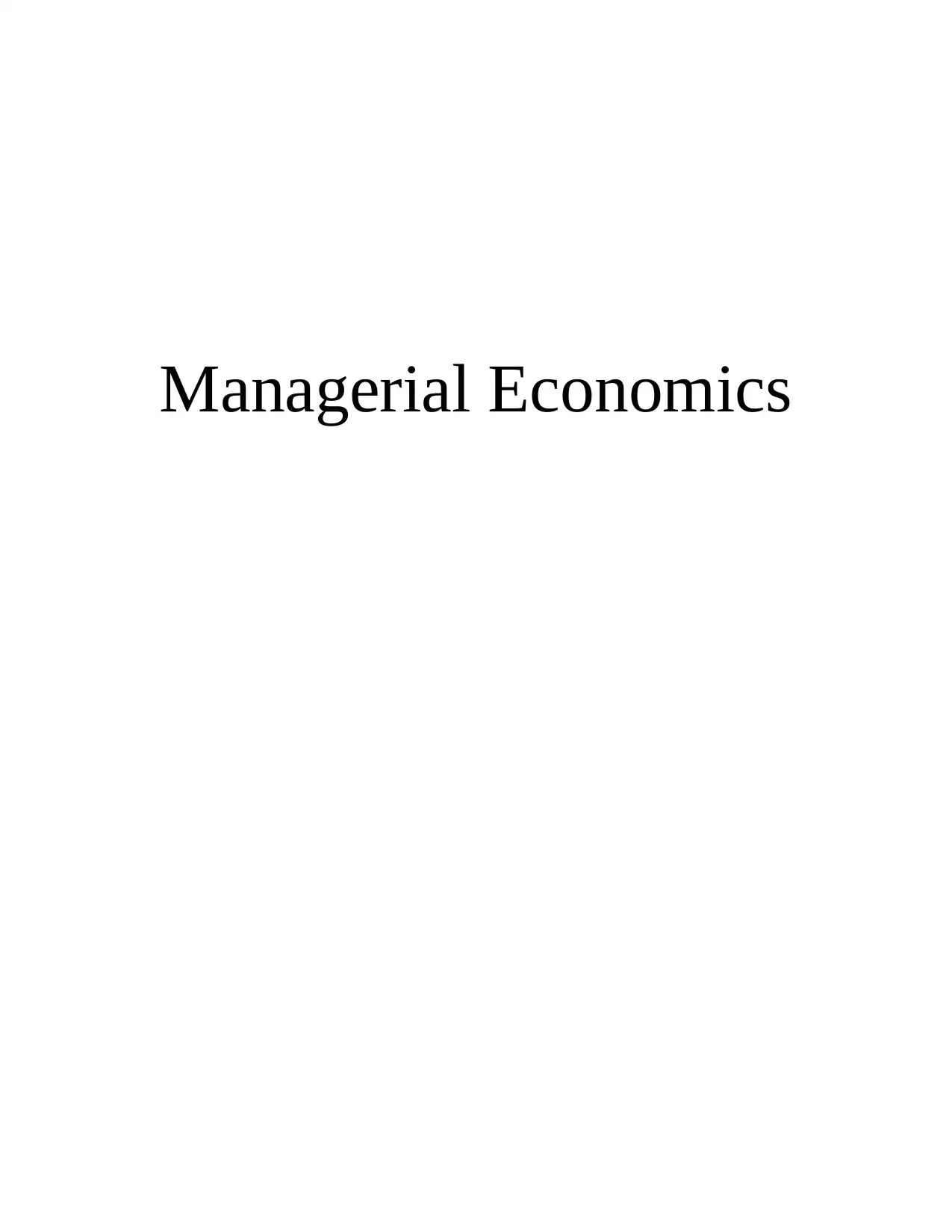
Managerial Economics
Paraphrase This Document
Need a fresh take? Get an instant paraphrase of this document with our AI Paraphraser
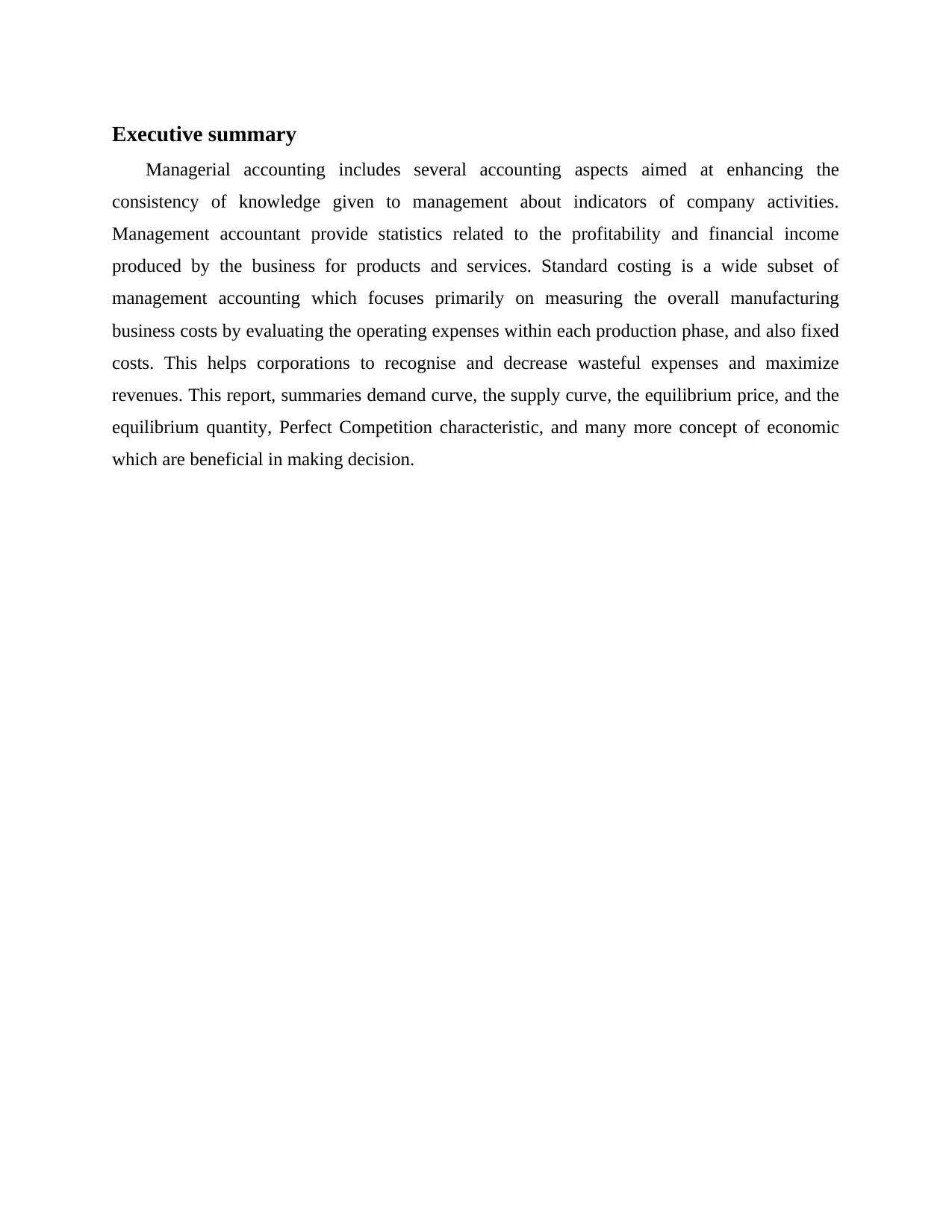
Executive summary
Managerial accounting includes several accounting aspects aimed at enhancing the
consistency of knowledge given to management about indicators of company activities.
Management accountant provide statistics related to the profitability and financial income
produced by the business for products and services. Standard costing is a wide subset of
management accounting which focuses primarily on measuring the overall manufacturing
business costs by evaluating the operating expenses within each production phase, and also fixed
costs. This helps corporations to recognise and decrease wasteful expenses and maximize
revenues. This report, summaries demand curve, the supply curve, the equilibrium price, and the
equilibrium quantity, Perfect Competition characteristic, and many more concept of economic
which are beneficial in making decision.
Managerial accounting includes several accounting aspects aimed at enhancing the
consistency of knowledge given to management about indicators of company activities.
Management accountant provide statistics related to the profitability and financial income
produced by the business for products and services. Standard costing is a wide subset of
management accounting which focuses primarily on measuring the overall manufacturing
business costs by evaluating the operating expenses within each production phase, and also fixed
costs. This helps corporations to recognise and decrease wasteful expenses and maximize
revenues. This report, summaries demand curve, the supply curve, the equilibrium price, and the
equilibrium quantity, Perfect Competition characteristic, and many more concept of economic
which are beneficial in making decision.
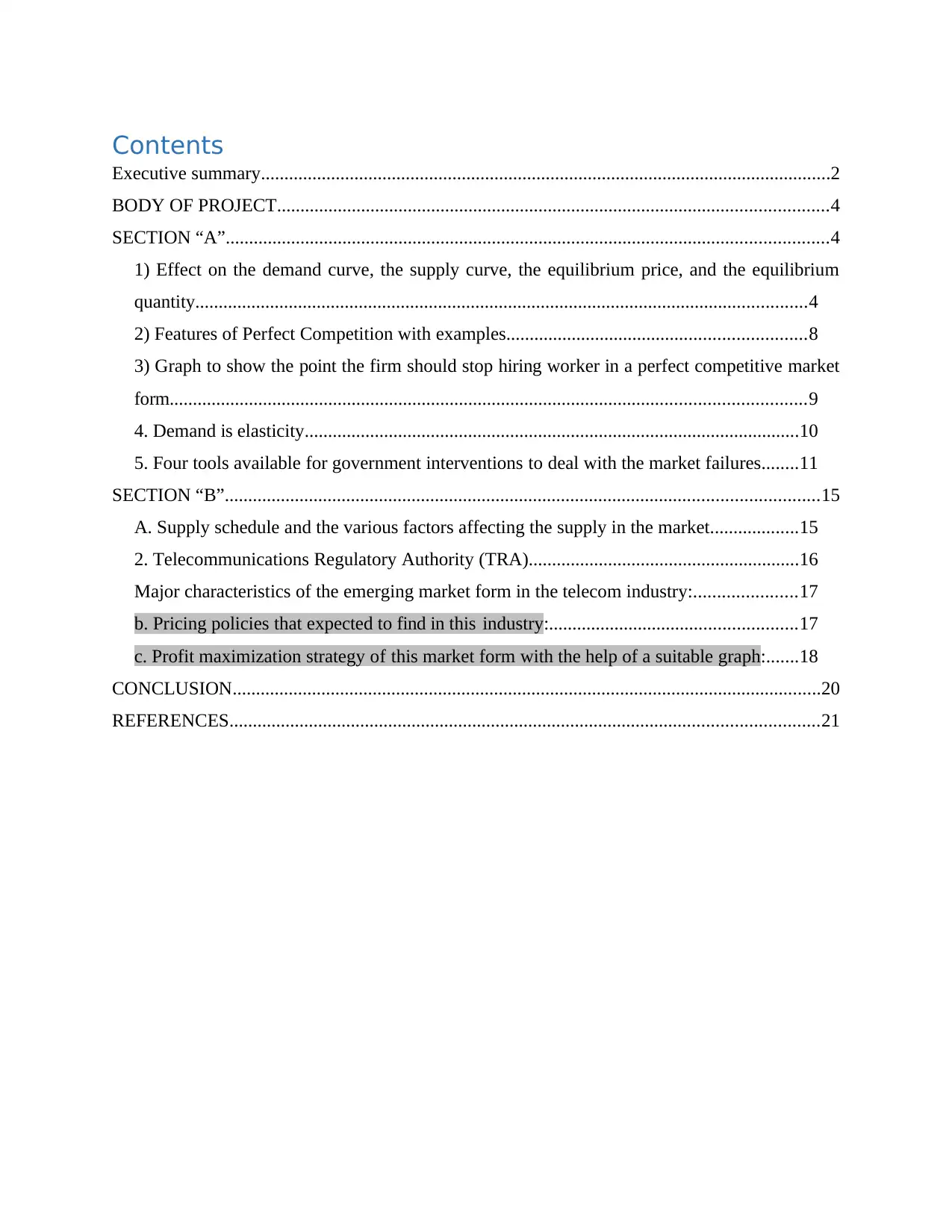
Contents
Executive summary..........................................................................................................................2
BODY OF PROJECT......................................................................................................................4
SECTION “A”.................................................................................................................................4
1) Effect on the demand curve, the supply curve, the equilibrium price, and the equilibrium
quantity...................................................................................................................................4
2) Features of Perfect Competition with examples................................................................8
3) Graph to show the point the firm should stop hiring worker in a perfect competitive market
form........................................................................................................................................9
4. Demand is elasticity..........................................................................................................10
5. Four tools available for government interventions to deal with the market failures........11
SECTION “B”...............................................................................................................................15
A. Supply schedule and the various factors affecting the supply in the market...................15
2. Telecommunications Regulatory Authority (TRA)..........................................................16
Major characteristics of the emerging market form in the telecom industry:......................17
b. Pricing policies that expected to find in this industry:.....................................................17
c. Profit maximization strategy of this market form with the help of a suitable graph:.......18
CONCLUSION..............................................................................................................................20
REFERENCES..............................................................................................................................21
Executive summary..........................................................................................................................2
BODY OF PROJECT......................................................................................................................4
SECTION “A”.................................................................................................................................4
1) Effect on the demand curve, the supply curve, the equilibrium price, and the equilibrium
quantity...................................................................................................................................4
2) Features of Perfect Competition with examples................................................................8
3) Graph to show the point the firm should stop hiring worker in a perfect competitive market
form........................................................................................................................................9
4. Demand is elasticity..........................................................................................................10
5. Four tools available for government interventions to deal with the market failures........11
SECTION “B”...............................................................................................................................15
A. Supply schedule and the various factors affecting the supply in the market...................15
2. Telecommunications Regulatory Authority (TRA)..........................................................16
Major characteristics of the emerging market form in the telecom industry:......................17
b. Pricing policies that expected to find in this industry:.....................................................17
c. Profit maximization strategy of this market form with the help of a suitable graph:.......18
CONCLUSION..............................................................................................................................20
REFERENCES..............................................................................................................................21
⊘ This is a preview!⊘
Do you want full access?
Subscribe today to unlock all pages.

Trusted by 1+ million students worldwide
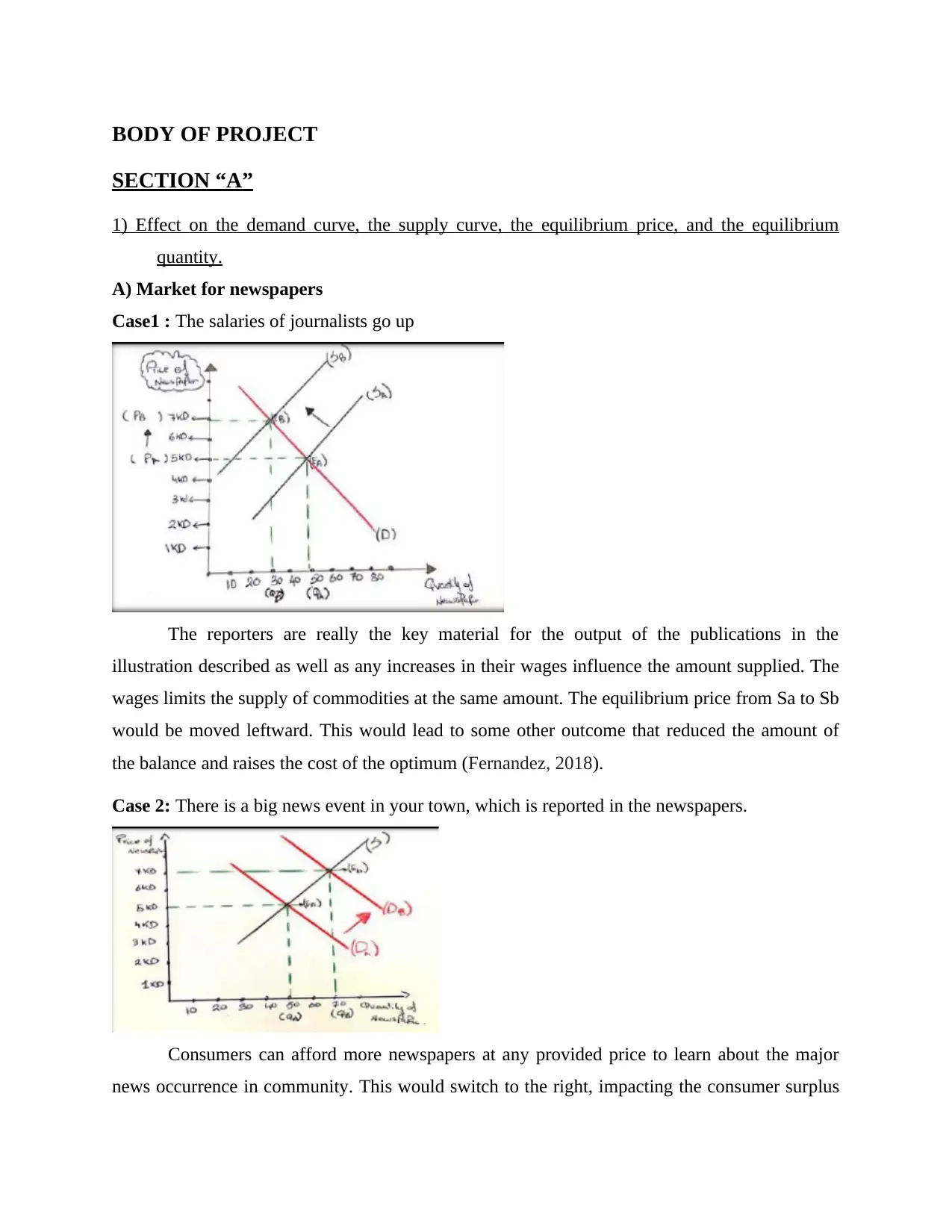
BODY OF PROJECT
SECTION “A”
1) Effect on the demand curve, the supply curve, the equilibrium price, and the equilibrium
quantity.
A) Market for newspapers
Case1 : The salaries of journalists go up
The reporters are really the key material for the output of the publications in the
illustration described as well as any increases in their wages influence the amount supplied. The
wages limits the supply of commodities at the same amount. The equilibrium price from Sa to Sb
would be moved leftward. This would lead to some other outcome that reduced the amount of
the balance and raises the cost of the optimum (Fernandez, 2018).
Case 2: There is a big news event in your town, which is reported in the newspapers.
Consumers can afford more newspapers at any provided price to learn about the major
news occurrence in community. This would switch to the right, impacting the consumer surplus
SECTION “A”
1) Effect on the demand curve, the supply curve, the equilibrium price, and the equilibrium
quantity.
A) Market for newspapers
Case1 : The salaries of journalists go up
The reporters are really the key material for the output of the publications in the
illustration described as well as any increases in their wages influence the amount supplied. The
wages limits the supply of commodities at the same amount. The equilibrium price from Sa to Sb
would be moved leftward. This would lead to some other outcome that reduced the amount of
the balance and raises the cost of the optimum (Fernandez, 2018).
Case 2: There is a big news event in your town, which is reported in the newspapers.
Consumers can afford more newspapers at any provided price to learn about the major
news occurrence in community. This would switch to the right, impacting the consumer surplus
Paraphrase This Document
Need a fresh take? Get an instant paraphrase of this document with our AI Paraphraser
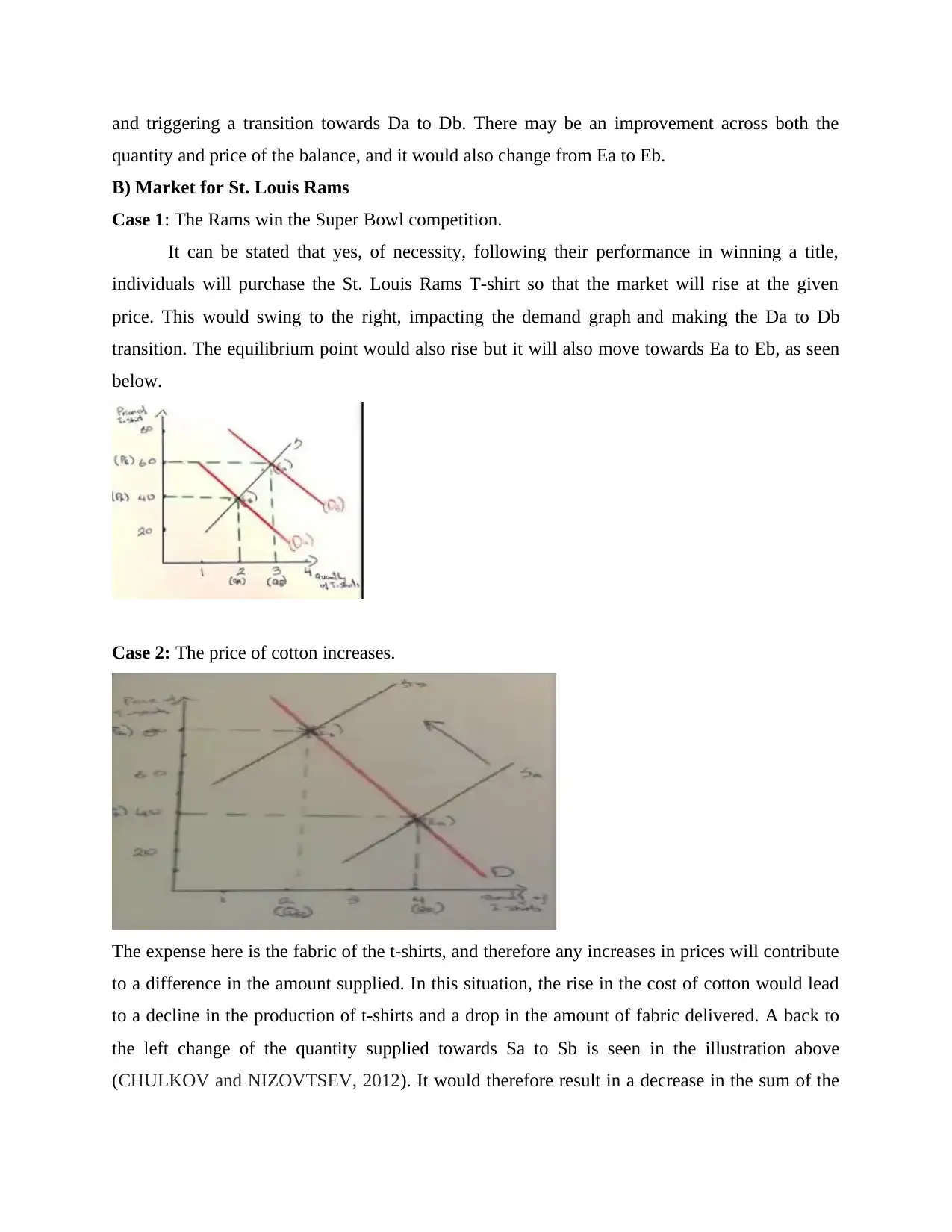
and triggering a transition towards Da to Db. There may be an improvement across both the
quantity and price of the balance, and it would also change from Ea to Eb.
B) Market for St. Louis Rams
Case 1: The Rams win the Super Bowl competition.
It can be stated that yes, of necessity, following their performance in winning a title,
individuals will purchase the St. Louis Rams T-shirt so that the market will rise at the given
price. This would swing to the right, impacting the demand graph and making the Da to Db
transition. The equilibrium point would also rise but it will also move towards Ea to Eb, as seen
below.
Case 2: The price of cotton increases.
The expense here is the fabric of the t-shirts, and therefore any increases in prices will contribute
to a difference in the amount supplied. In this situation, the rise in the cost of cotton would lead
to a decline in the production of t-shirts and a drop in the amount of fabric delivered. A back to
the left change of the quantity supplied towards Sa to Sb is seen in the illustration above
(CHULKOV and NIZOVTSEV, 2012). It would therefore result in a decrease in the sum of the
quantity and price of the balance, and it would also change from Ea to Eb.
B) Market for St. Louis Rams
Case 1: The Rams win the Super Bowl competition.
It can be stated that yes, of necessity, following their performance in winning a title,
individuals will purchase the St. Louis Rams T-shirt so that the market will rise at the given
price. This would swing to the right, impacting the demand graph and making the Da to Db
transition. The equilibrium point would also rise but it will also move towards Ea to Eb, as seen
below.
Case 2: The price of cotton increases.
The expense here is the fabric of the t-shirts, and therefore any increases in prices will contribute
to a difference in the amount supplied. In this situation, the rise in the cost of cotton would lead
to a decline in the production of t-shirts and a drop in the amount of fabric delivered. A back to
the left change of the quantity supplied towards Sa to Sb is seen in the illustration above
(CHULKOV and NIZOVTSEV, 2012). It would therefore result in a decrease in the sum of the
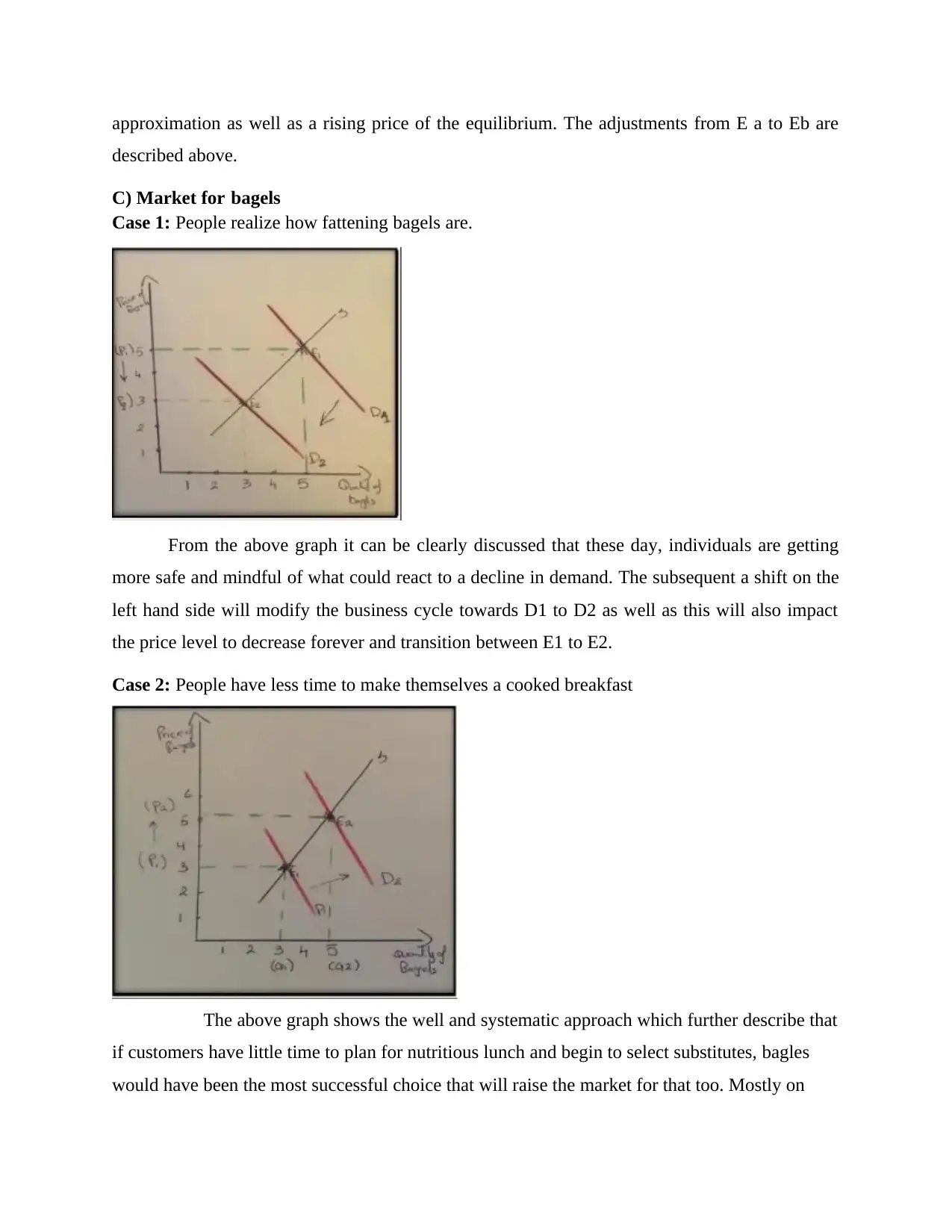
approximation as well as a rising price of the equilibrium. The adjustments from E a to Eb are
described above.
C) Market for bagels
Case 1: People realize how fattening bagels are.
From the above graph it can be clearly discussed that these day, individuals are getting
more safe and mindful of what could react to a decline in demand. The subsequent a shift on the
left hand side will modify the business cycle towards D1 to D2 as well as this will also impact
the price level to decrease forever and transition between E1 to E2.
Case 2: People have less time to make themselves a cooked breakfast
The above graph shows the well and systematic approach which further describe that
if customers have little time to plan for nutritious lunch and begin to select substitutes, bagles
would have been the most successful choice that will raise the market for that too. Mostly on
described above.
C) Market for bagels
Case 1: People realize how fattening bagels are.
From the above graph it can be clearly discussed that these day, individuals are getting
more safe and mindful of what could react to a decline in demand. The subsequent a shift on the
left hand side will modify the business cycle towards D1 to D2 as well as this will also impact
the price level to decrease forever and transition between E1 to E2.
Case 2: People have less time to make themselves a cooked breakfast
The above graph shows the well and systematic approach which further describe that
if customers have little time to plan for nutritious lunch and begin to select substitutes, bagles
would have been the most successful choice that will raise the market for that too. Mostly on
⊘ This is a preview!⊘
Do you want full access?
Subscribe today to unlock all pages.

Trusted by 1+ million students worldwide
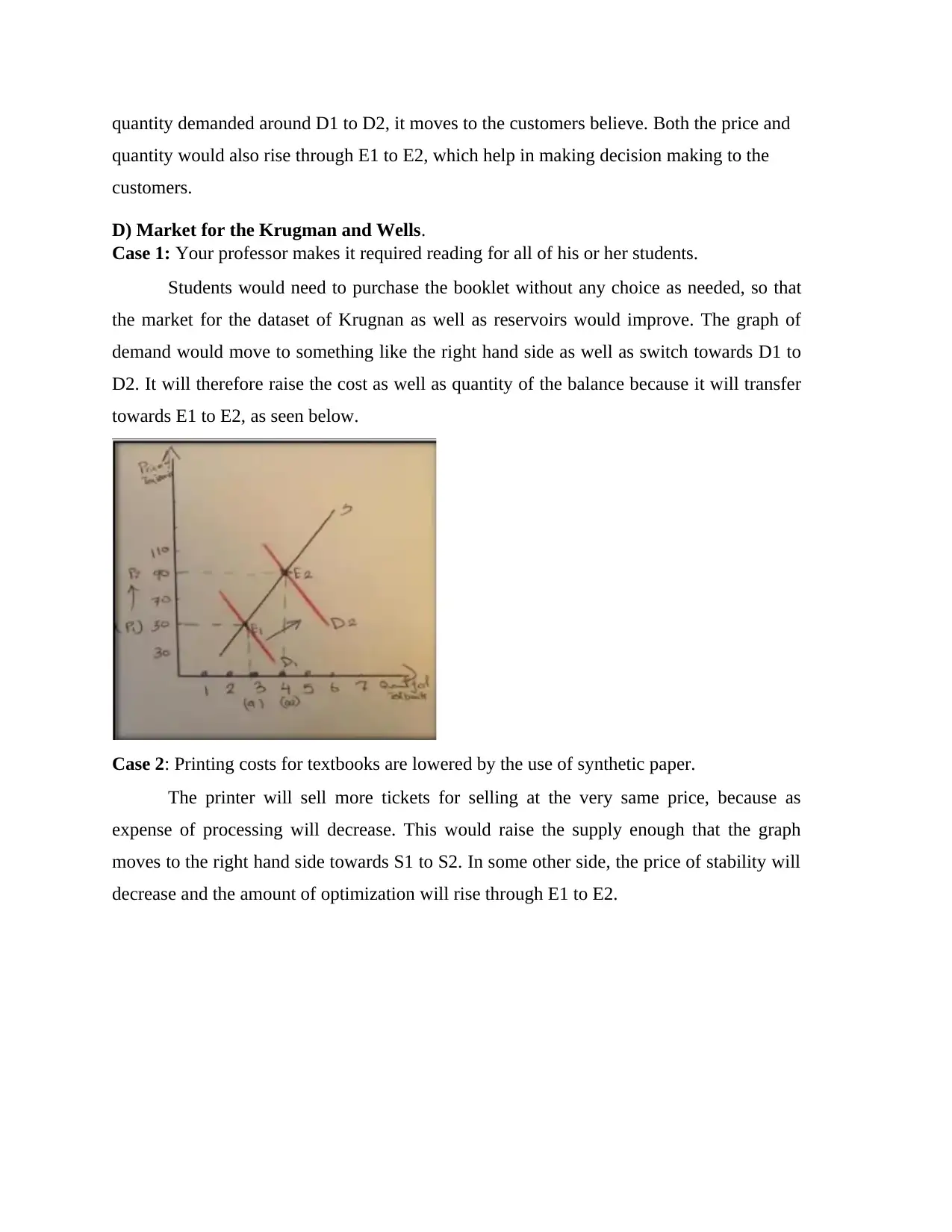
quantity demanded around D1 to D2, it moves to the customers believe. Both the price and
quantity would also rise through E1 to E2, which help in making decision making to the
customers.
D) Market for the Krugman and Wells.
Case 1: Your professor makes it required reading for all of his or her students.
Students would need to purchase the booklet without any choice as needed, so that
the market for the dataset of Krugnan as well as reservoirs would improve. The graph of
demand would move to something like the right hand side as well as switch towards D1 to
D2. It will therefore raise the cost as well as quantity of the balance because it will transfer
towards E1 to E2, as seen below.
Case 2: Printing costs for textbooks are lowered by the use of synthetic paper.
The printer will sell more tickets for selling at the very same price, because as
expense of processing will decrease. This would raise the supply enough that the graph
moves to the right hand side towards S1 to S2. In some other side, the price of stability will
decrease and the amount of optimization will rise through E1 to E2.
quantity would also rise through E1 to E2, which help in making decision making to the
customers.
D) Market for the Krugman and Wells.
Case 1: Your professor makes it required reading for all of his or her students.
Students would need to purchase the booklet without any choice as needed, so that
the market for the dataset of Krugnan as well as reservoirs would improve. The graph of
demand would move to something like the right hand side as well as switch towards D1 to
D2. It will therefore raise the cost as well as quantity of the balance because it will transfer
towards E1 to E2, as seen below.
Case 2: Printing costs for textbooks are lowered by the use of synthetic paper.
The printer will sell more tickets for selling at the very same price, because as
expense of processing will decrease. This would raise the supply enough that the graph
moves to the right hand side towards S1 to S2. In some other side, the price of stability will
decrease and the amount of optimization will rise through E1 to E2.
Paraphrase This Document
Need a fresh take? Get an instant paraphrase of this document with our AI Paraphraser
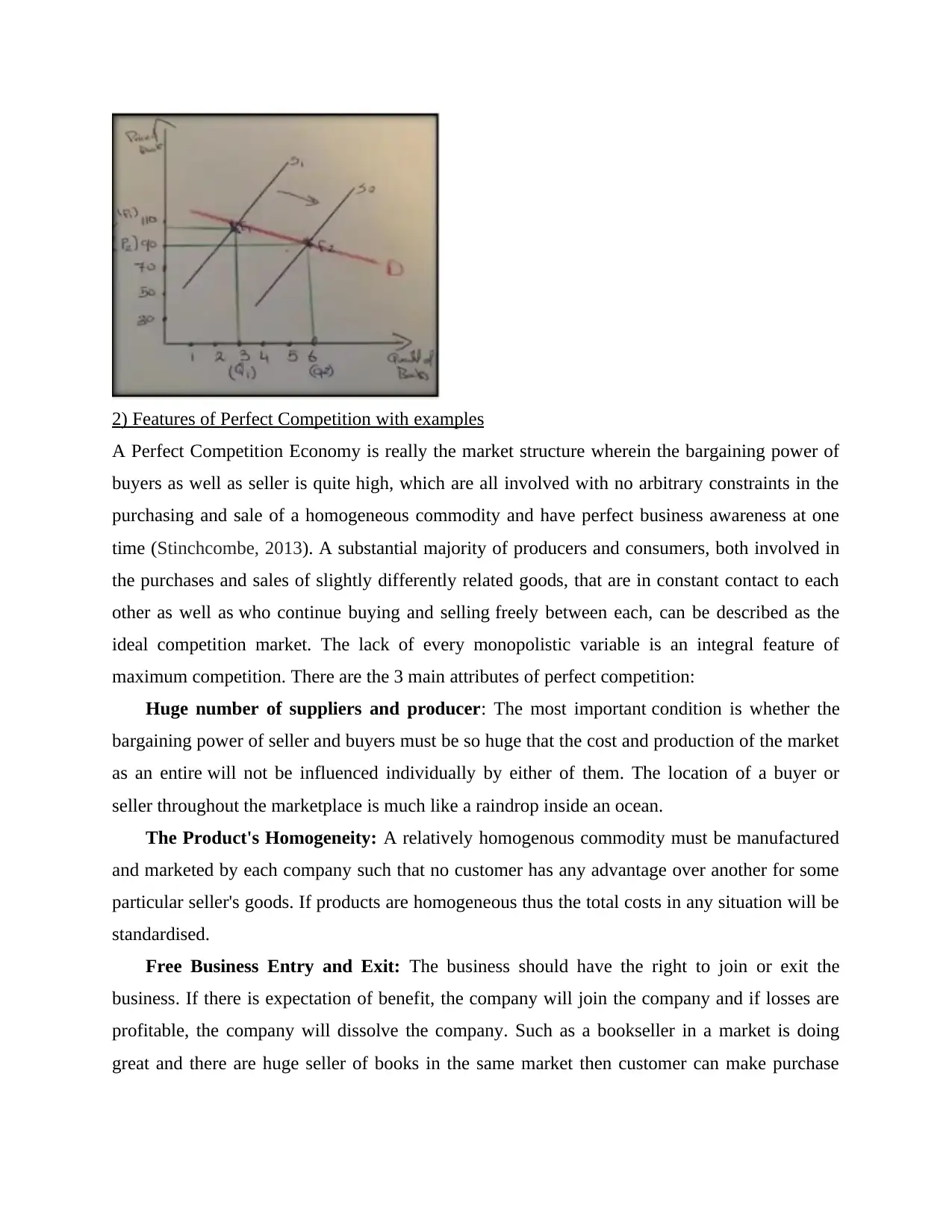
2) Features of Perfect Competition with examples
A Perfect Competition Economy is really the market structure wherein the bargaining power of
buyers as well as seller is quite high, which are all involved with no arbitrary constraints in the
purchasing and sale of a homogeneous commodity and have perfect business awareness at one
time (Stinchcombe, 2013). A substantial majority of producers and consumers, both involved in
the purchases and sales of slightly differently related goods, that are in constant contact to each
other as well as who continue buying and selling freely between each, can be described as the
ideal competition market. The lack of every monopolistic variable is an integral feature of
maximum competition. There are the 3 main attributes of perfect competition:
Huge number of suppliers and producer: The most important condition is whether the
bargaining power of seller and buyers must be so huge that the cost and production of the market
as an entire will not be influenced individually by either of them. The location of a buyer or
seller throughout the marketplace is much like a raindrop inside an ocean.
The Product's Homogeneity: A relatively homogenous commodity must be manufactured
and marketed by each company such that no customer has any advantage over another for some
particular seller's goods. If products are homogeneous thus the total costs in any situation will be
standardised.
Free Business Entry and Exit: The business should have the right to join or exit the
business. If there is expectation of benefit, the company will join the company and if losses are
profitable, the company will dissolve the company. Such as a bookseller in a market is doing
great and there are huge seller of books in the same market then customer can make purchase
A Perfect Competition Economy is really the market structure wherein the bargaining power of
buyers as well as seller is quite high, which are all involved with no arbitrary constraints in the
purchasing and sale of a homogeneous commodity and have perfect business awareness at one
time (Stinchcombe, 2013). A substantial majority of producers and consumers, both involved in
the purchases and sales of slightly differently related goods, that are in constant contact to each
other as well as who continue buying and selling freely between each, can be described as the
ideal competition market. The lack of every monopolistic variable is an integral feature of
maximum competition. There are the 3 main attributes of perfect competition:
Huge number of suppliers and producer: The most important condition is whether the
bargaining power of seller and buyers must be so huge that the cost and production of the market
as an entire will not be influenced individually by either of them. The location of a buyer or
seller throughout the marketplace is much like a raindrop inside an ocean.
The Product's Homogeneity: A relatively homogenous commodity must be manufactured
and marketed by each company such that no customer has any advantage over another for some
particular seller's goods. If products are homogeneous thus the total costs in any situation will be
standardised.
Free Business Entry and Exit: The business should have the right to join or exit the
business. If there is expectation of benefit, the company will join the company and if losses are
profitable, the company will dissolve the company. Such as a bookseller in a market is doing
great and there are huge seller of books in the same market then customer can make purchase
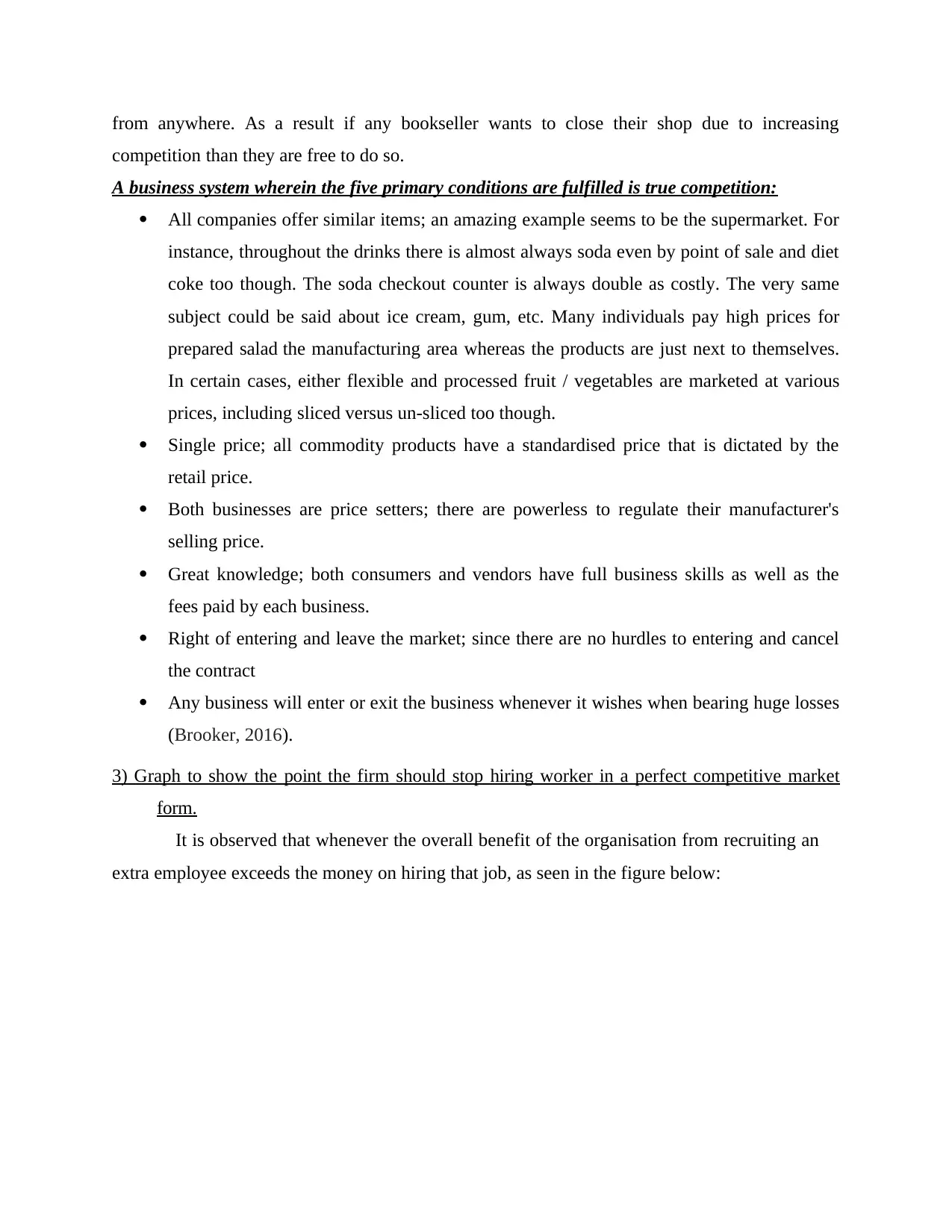
from anywhere. As a result if any bookseller wants to close their shop due to increasing
competition than they are free to do so.
A business system wherein the five primary conditions are fulfilled is true competition:
All companies offer similar items; an amazing example seems to be the supermarket. For
instance, throughout the drinks there is almost always soda even by point of sale and diet
coke too though. The soda checkout counter is always double as costly. The very same
subject could be said about ice cream, gum, etc. Many individuals pay high prices for
prepared salad the manufacturing area whereas the products are just next to themselves.
In certain cases, either flexible and processed fruit / vegetables are marketed at various
prices, including sliced versus un-sliced too though.
Single price; all commodity products have a standardised price that is dictated by the
retail price.
Both businesses are price setters; there are powerless to regulate their manufacturer's
selling price.
Great knowledge; both consumers and vendors have full business skills as well as the
fees paid by each business.
Right of entering and leave the market; since there are no hurdles to entering and cancel
the contract
Any business will enter or exit the business whenever it wishes when bearing huge losses
(Brooker, 2016).
3) Graph to show the point the firm should stop hiring worker in a perfect competitive market
form.
It is observed that whenever the overall benefit of the organisation from recruiting an
extra employee exceeds the money on hiring that job, as seen in the figure below:
competition than they are free to do so.
A business system wherein the five primary conditions are fulfilled is true competition:
All companies offer similar items; an amazing example seems to be the supermarket. For
instance, throughout the drinks there is almost always soda even by point of sale and diet
coke too though. The soda checkout counter is always double as costly. The very same
subject could be said about ice cream, gum, etc. Many individuals pay high prices for
prepared salad the manufacturing area whereas the products are just next to themselves.
In certain cases, either flexible and processed fruit / vegetables are marketed at various
prices, including sliced versus un-sliced too though.
Single price; all commodity products have a standardised price that is dictated by the
retail price.
Both businesses are price setters; there are powerless to regulate their manufacturer's
selling price.
Great knowledge; both consumers and vendors have full business skills as well as the
fees paid by each business.
Right of entering and leave the market; since there are no hurdles to entering and cancel
the contract
Any business will enter or exit the business whenever it wishes when bearing huge losses
(Brooker, 2016).
3) Graph to show the point the firm should stop hiring worker in a perfect competitive market
form.
It is observed that whenever the overall benefit of the organisation from recruiting an
extra employee exceeds the money on hiring that job, as seen in the figure below:
⊘ This is a preview!⊘
Do you want full access?
Subscribe today to unlock all pages.

Trusted by 1+ million students worldwide
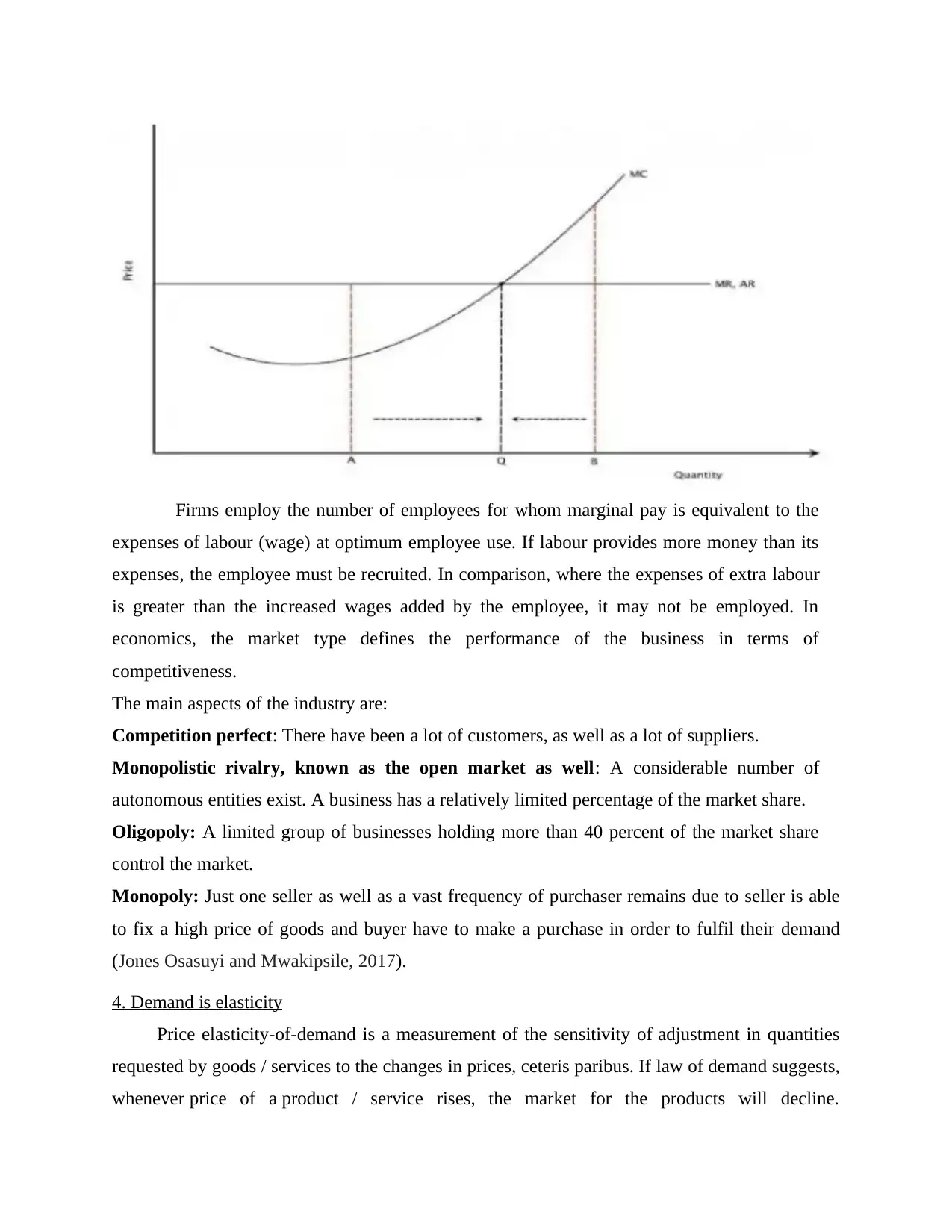
Firms employ the number of employees for whom marginal pay is equivalent to the
expenses of labour (wage) at optimum employee use. If labour provides more money than its
expenses, the employee must be recruited. In comparison, where the expenses of extra labour
is greater than the increased wages added by the employee, it may not be employed. In
economics, the market type defines the performance of the business in terms of
competitiveness.
The main aspects of the industry are:
Competition perfect: There have been a lot of customers, as well as a lot of suppliers.
Monopolistic rivalry, known as the open market as well: A considerable number of
autonomous entities exist. A business has a relatively limited percentage of the market share.
Oligopoly: A limited group of businesses holding more than 40 percent of the market share
control the market.
Monopoly: Just one seller as well as a vast frequency of purchaser remains due to seller is able
to fix a high price of goods and buyer have to make a purchase in order to fulfil their demand
(Jones Osasuyi and Mwakipsile, 2017).
4. Demand is elasticity
Price elasticity-of-demand is a measurement of the sensitivity of adjustment in quantities
requested by goods / services to the changes in prices, ceteris paribus. If law of demand suggests,
whenever price of a product / service rises, the market for the products will decline.
expenses of labour (wage) at optimum employee use. If labour provides more money than its
expenses, the employee must be recruited. In comparison, where the expenses of extra labour
is greater than the increased wages added by the employee, it may not be employed. In
economics, the market type defines the performance of the business in terms of
competitiveness.
The main aspects of the industry are:
Competition perfect: There have been a lot of customers, as well as a lot of suppliers.
Monopolistic rivalry, known as the open market as well: A considerable number of
autonomous entities exist. A business has a relatively limited percentage of the market share.
Oligopoly: A limited group of businesses holding more than 40 percent of the market share
control the market.
Monopoly: Just one seller as well as a vast frequency of purchaser remains due to seller is able
to fix a high price of goods and buyer have to make a purchase in order to fulfil their demand
(Jones Osasuyi and Mwakipsile, 2017).
4. Demand is elasticity
Price elasticity-of-demand is a measurement of the sensitivity of adjustment in quantities
requested by goods / services to the changes in prices, ceteris paribus. If law of demand suggests,
whenever price of a product / service rises, the market for the products will decline.
Paraphrase This Document
Need a fresh take? Get an instant paraphrase of this document with our AI Paraphraser
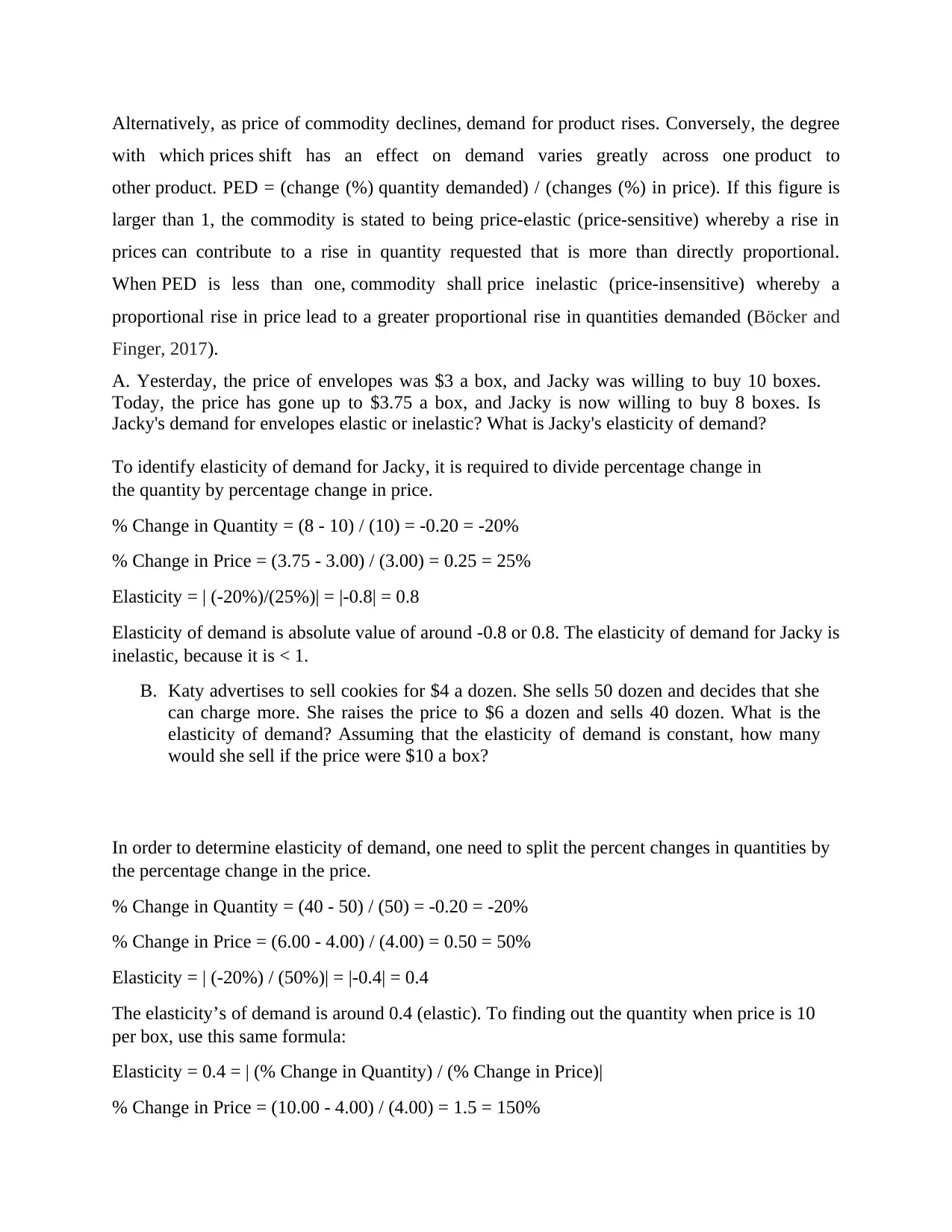
Alternatively, as price of commodity declines, demand for product rises. Conversely, the degree
with which prices shift has an effect on demand varies greatly across one product to
other product. PED = (change (%) quantity demanded) / (changes (%) in price). If this figure is
larger than 1, the commodity is stated to being price-elastic (price-sensitive) whereby a rise in
prices can contribute to a rise in quantity requested that is more than directly proportional.
When PED is less than one, commodity shall price inelastic (price-insensitive) whereby a
proportional rise in price lead to a greater proportional rise in quantities demanded (Böcker and
Finger, 2017).
A. Yesterday, the price of envelopes was $3 a box, and Jacky was willing to buy 10 boxes.
Today, the price has gone up to $3.75 a box, and Jacky is now willing to buy 8 boxes. Is
Jacky's demand for envelopes elastic or inelastic? What is Jacky's elasticity of demand?
To identify elasticity of demand for Jacky, it is required to divide percentage change in
the quantity by percentage change in price.
% Change in Quantity = (8 - 10) / (10) = -0.20 = -20%
% Change in Price = (3.75 - 3.00) / (3.00) = 0.25 = 25%
Elasticity = | (-20%)/(25%)| = |-0.8| = 0.8
Elasticity of demand is absolute value of around -0.8 or 0.8. The elasticity of demand for Jacky is
inelastic, because it is < 1.
B. Katy advertises to sell cookies for $4 a dozen. She sells 50 dozen and decides that she
can charge more. She raises the price to $6 a dozen and sells 40 dozen. What is the
elasticity of demand? Assuming that the elasticity of demand is constant, how many
would she sell if the price were $10 a box?
In order to determine elasticity of demand, one need to split the percent changes in quantities by
the percentage change in the price.
% Change in Quantity = (40 - 50) / (50) = -0.20 = -20%
% Change in Price = (6.00 - 4.00) / (4.00) = 0.50 = 50%
Elasticity = | (-20%) / (50%)| = |-0.4| = 0.4
The elasticity’s of demand is around 0.4 (elastic). To finding out the quantity when price is 10
per box, use this same formula:
Elasticity = 0.4 = | (% Change in Quantity) / (% Change in Price)|
% Change in Price = (10.00 - 4.00) / (4.00) = 1.5 = 150%
with which prices shift has an effect on demand varies greatly across one product to
other product. PED = (change (%) quantity demanded) / (changes (%) in price). If this figure is
larger than 1, the commodity is stated to being price-elastic (price-sensitive) whereby a rise in
prices can contribute to a rise in quantity requested that is more than directly proportional.
When PED is less than one, commodity shall price inelastic (price-insensitive) whereby a
proportional rise in price lead to a greater proportional rise in quantities demanded (Böcker and
Finger, 2017).
A. Yesterday, the price of envelopes was $3 a box, and Jacky was willing to buy 10 boxes.
Today, the price has gone up to $3.75 a box, and Jacky is now willing to buy 8 boxes. Is
Jacky's demand for envelopes elastic or inelastic? What is Jacky's elasticity of demand?
To identify elasticity of demand for Jacky, it is required to divide percentage change in
the quantity by percentage change in price.
% Change in Quantity = (8 - 10) / (10) = -0.20 = -20%
% Change in Price = (3.75 - 3.00) / (3.00) = 0.25 = 25%
Elasticity = | (-20%)/(25%)| = |-0.8| = 0.8
Elasticity of demand is absolute value of around -0.8 or 0.8. The elasticity of demand for Jacky is
inelastic, because it is < 1.
B. Katy advertises to sell cookies for $4 a dozen. She sells 50 dozen and decides that she
can charge more. She raises the price to $6 a dozen and sells 40 dozen. What is the
elasticity of demand? Assuming that the elasticity of demand is constant, how many
would she sell if the price were $10 a box?
In order to determine elasticity of demand, one need to split the percent changes in quantities by
the percentage change in the price.
% Change in Quantity = (40 - 50) / (50) = -0.20 = -20%
% Change in Price = (6.00 - 4.00) / (4.00) = 0.50 = 50%
Elasticity = | (-20%) / (50%)| = |-0.4| = 0.4
The elasticity’s of demand is around 0.4 (elastic). To finding out the quantity when price is 10
per box, use this same formula:
Elasticity = 0.4 = | (% Change in Quantity) / (% Change in Price)|
% Change in Price = (10.00 - 4.00) / (4.00) = 1.5 = 150%
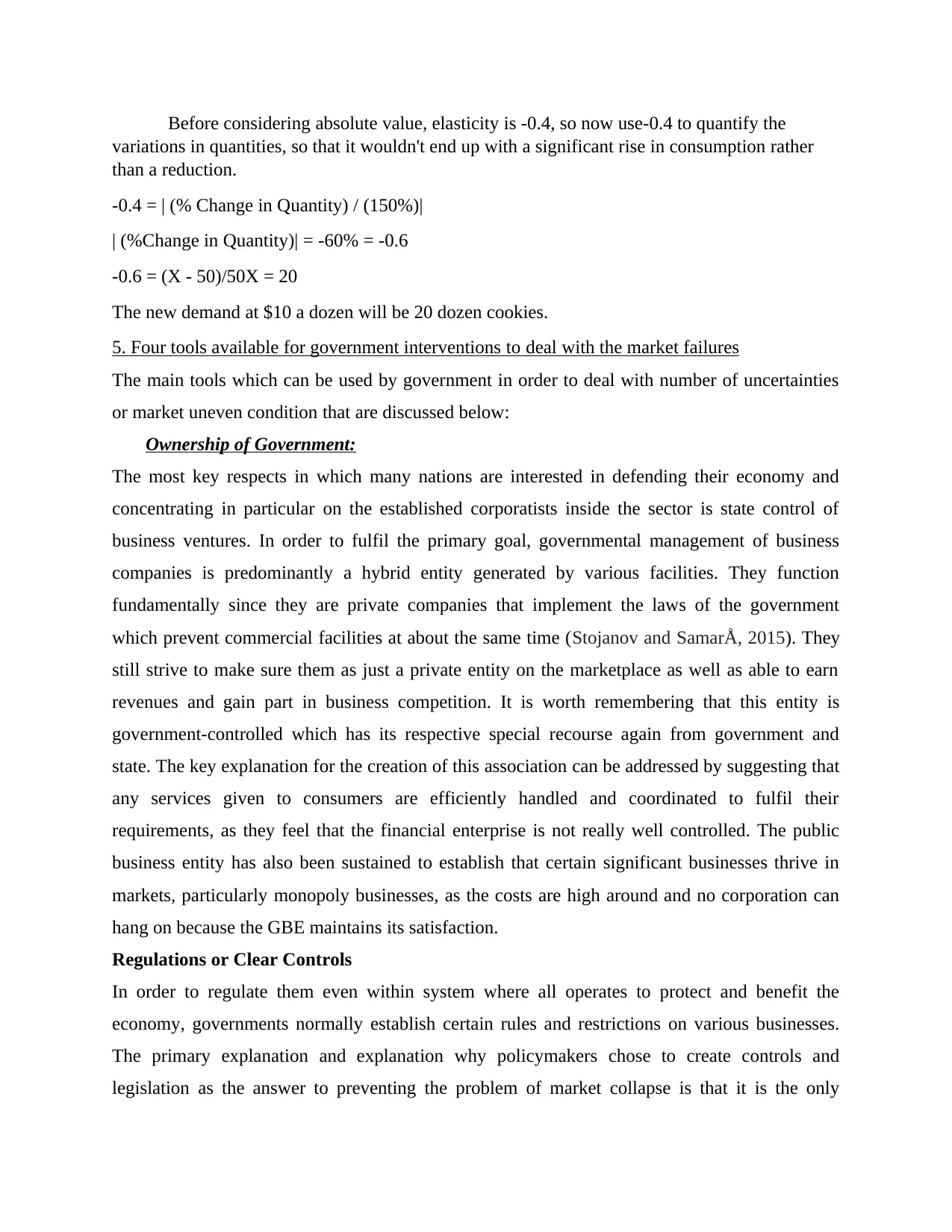
Before considering absolute value, elasticity is -0.4, so now use-0.4 to quantify the
variations in quantities, so that it wouldn't end up with a significant rise in consumption rather
than a reduction.
-0.4 = | (% Change in Quantity) / (150%)|
| (%Change in Quantity)| = -60% = -0.6
-0.6 = (X - 50)/50X = 20
The new demand at $10 a dozen will be 20 dozen cookies.
5. Four tools available for government interventions to deal with the market failures
The main tools which can be used by government in order to deal with number of uncertainties
or market uneven condition that are discussed below:
Ownership of Government:
The most key respects in which many nations are interested in defending their economy and
concentrating in particular on the established corporatists inside the sector is state control of
business ventures. In order to fulfil the primary goal, governmental management of business
companies is predominantly a hybrid entity generated by various facilities. They function
fundamentally since they are private companies that implement the laws of the government
which prevent commercial facilities at about the same time (Stojanov and SamarÅ, 2015). They
still strive to make sure them as just a private entity on the marketplace as well as able to earn
revenues and gain part in business competition. It is worth remembering that this entity is
government-controlled which has its respective special recourse again from government and
state. The key explanation for the creation of this association can be addressed by suggesting that
any services given to consumers are efficiently handled and coordinated to fulfil their
requirements, as they feel that the financial enterprise is not really well controlled. The public
business entity has also been sustained to establish that certain significant businesses thrive in
markets, particularly monopoly businesses, as the costs are high around and no corporation can
hang on because the GBE maintains its satisfaction.
Regulations or Clear Controls
In order to regulate them even within system where all operates to protect and benefit the
economy, governments normally establish certain rules and restrictions on various businesses.
The primary explanation and explanation why policymakers chose to create controls and
legislation as the answer to preventing the problem of market collapse is that it is the only
variations in quantities, so that it wouldn't end up with a significant rise in consumption rather
than a reduction.
-0.4 = | (% Change in Quantity) / (150%)|
| (%Change in Quantity)| = -60% = -0.6
-0.6 = (X - 50)/50X = 20
The new demand at $10 a dozen will be 20 dozen cookies.
5. Four tools available for government interventions to deal with the market failures
The main tools which can be used by government in order to deal with number of uncertainties
or market uneven condition that are discussed below:
Ownership of Government:
The most key respects in which many nations are interested in defending their economy and
concentrating in particular on the established corporatists inside the sector is state control of
business ventures. In order to fulfil the primary goal, governmental management of business
companies is predominantly a hybrid entity generated by various facilities. They function
fundamentally since they are private companies that implement the laws of the government
which prevent commercial facilities at about the same time (Stojanov and SamarÅ, 2015). They
still strive to make sure them as just a private entity on the marketplace as well as able to earn
revenues and gain part in business competition. It is worth remembering that this entity is
government-controlled which has its respective special recourse again from government and
state. The key explanation for the creation of this association can be addressed by suggesting that
any services given to consumers are efficiently handled and coordinated to fulfil their
requirements, as they feel that the financial enterprise is not really well controlled. The public
business entity has also been sustained to establish that certain significant businesses thrive in
markets, particularly monopoly businesses, as the costs are high around and no corporation can
hang on because the GBE maintains its satisfaction.
Regulations or Clear Controls
In order to regulate them even within system where all operates to protect and benefit the
economy, governments normally establish certain rules and restrictions on various businesses.
The primary explanation and explanation why policymakers chose to create controls and
legislation as the answer to preventing the problem of market collapse is that it is the only
⊘ This is a preview!⊘
Do you want full access?
Subscribe today to unlock all pages.

Trusted by 1+ million students worldwide
1 out of 21
Related Documents
Your All-in-One AI-Powered Toolkit for Academic Success.
+13062052269
info@desklib.com
Available 24*7 on WhatsApp / Email
![[object Object]](/_next/static/media/star-bottom.7253800d.svg)
Unlock your academic potential
Copyright © 2020–2025 A2Z Services. All Rights Reserved. Developed and managed by ZUCOL.





